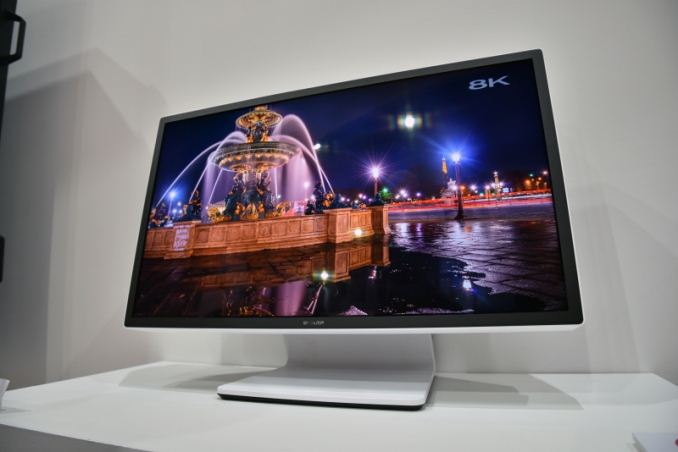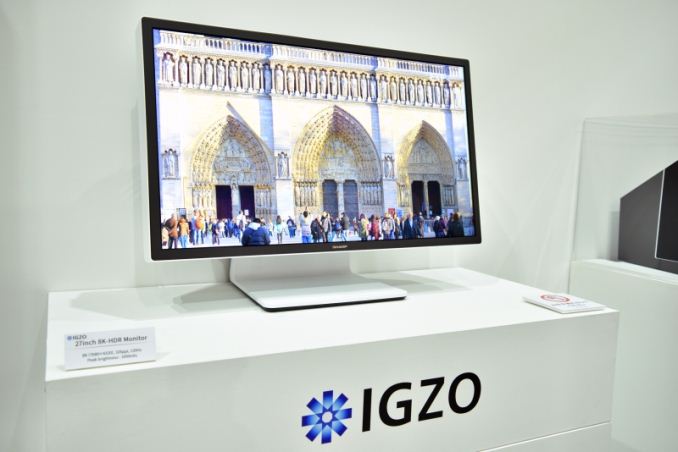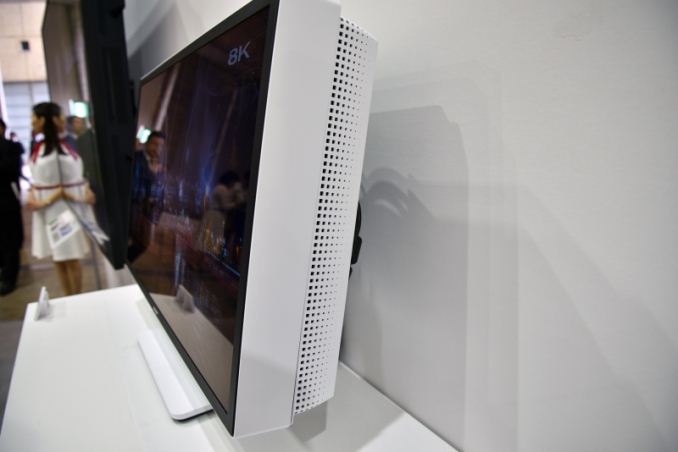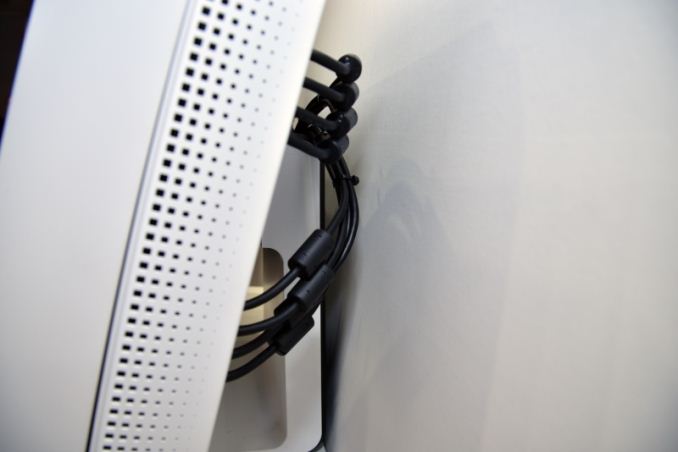CEATEC 2016: Sharp Showcases 27-inch 8K 120Hz IGZO Monitor with HDR, also 1000 PPI for VR
by Ian Cutress on October 5, 2016 10:15 AM EST- Posted in
- Monitors
- 120Hz
- DisplayPort
- Trade Shows
- Sharp
- IGZO
- 8K
- HDR
- CEATIC

While we’re not CEATEC, a Japanese technology show, news has come via PC Watch regarding a new publicly announced milestone in monitor production. For any journalist that has attended either IFA, Computex, CES or MWC over the past year, it would be hard going to miss one of the super large (80-inch plus) 8K monitors doing the rounds. While highly impressive in their own right, current 8K displays on show typically have a low pixel-per-inch value in order to achieve a good panel off the production line. So despite the fact we can get 4K panels on smartphones (Sony Xperia Z5 Premium is 4K in 5.5-inch, or 806 PPI), expanding the size at that pixel density is difficult with panel yields. Also, moving 8K down to a 'monitor size' has been hidden at the panel companies internal research divisions until now.
So this is where the Sharp monitor on display at CEATEC gets interesting. The IGZO display is down at 27-inches, marking a 326 PPI, just hitting at the door of large FHD smartphone displays. The panel is also listed at 1000 nit brightness. But to double down on specifications, the stand listed the display as supporting 120 Hz while in 8K mode, and also supporting High Dynamic Range, or HDR. This requires a large amount of data to be pumped into the display, and as a result a photograph of the rear shows eight separate DisplayPort cables being used in order to give the display the data it needs. 8K120 with HDR is no easy task, suggesting 7680x4320 at 10 bits per color channel (so 30-bit for RGB) at 120 times a second would suggest needing 120 gigabits per second of bandwidth at a minimum (or 15 GB/sec). That's even before you discuss overhead, which will push that higher.
Needless to say, this is a prototype panel. Businesses with large enough checkbooks are free to try and estimate a figure for such a display, because it will be a while before a device of these specifications hits commercial availability.
Also in the display was a 2.87-inch display, offering 1920x2160 resolution and rolling in at over 1000 pixels per inch (1008 PPI). This was described as ‘4K to both eyes’, affording a combined display suitable for head-mounted units or virtual reality headsets. Compare this to the HTC Vive, which uses a 1200x1080 screen per eye at 3.62 inches per panel, making it 447 PPI. This gives the Sharp panel a specification of over double the amount of pixels in a given area. Of course, with that comes cost and the ability to feed that display with enough data either over cable or other means. Still, it’s an interesting prospect.
Source: PC Watch














44 Comments
View All Comments
TristanSDX - Wednesday, October 5, 2016 - link
Do not write such comments, progress must be made to the limits. 8K (and futher 16K or 32K), give you quality so high, that computer generated artifical life will be preceived as real. 4K is not enough for it. You must see literally every hair to preceive that it is real.Azethoth - Wednesday, October 5, 2016 - link
Only the limits that have not been achieved yet. 4k on a monitor has pixels too small to see. We have an angular resolution limit. 4k for sure covers that on a phone. An 8k phone is one you don't need to buy ever. An 8k monitor at my current size of 32" and 2 foot or so viewing distance is likely overkill but I would order one to see. 16k+ would be stupid.What is not real about a photo has nothing to do with pixels anymore and everything to do with the lack of 3D and motion and color representation issues (both color space available and low HDR capability). After that becomes "real" you would then need to start fooling the other senses as well.
prisonerX - Wednesday, October 5, 2016 - link
"(6)4(0)K should be enough for anyone..."MTEK - Wednesday, October 5, 2016 - link
Eight DisplayPorts.... Where's superMHL when you need it.DanNeely - Wednesday, October 5, 2016 - link
Maybe fewer than 8 if they're testing newer versions of DP in that hardware as well. DisplayPort v.next includes a video compression mode; IIRC targeting 2:1 with no human perceptable impact to picture quality. (Should be doable since current compression can get several hundred to one without problematic artifacts.)repoman27 - Wednesday, October 5, 2016 - link
Pretty sure it's DP 1.2 seeing as there's probably a dearth of DP 1.3+ TCONs out there. Also, my napkin math works out to 127.751328 Gbit/s for SST, or 8 tiles at 16.4664 Gbit/s apiece using reduced blanking version 2, which would fit nicely into the 17.28 Gbit/s bandwidth of a DP 1.2 HBR2 main link. That's insane though. Whatever is driving that display needs to pump out 17.28 GB/s (capital "B") of display data if you count the bit-stuffing.jjj - Wednesday, October 5, 2016 - link
You left out the most interesting part https://ic.tweakimg.net/ext/i/2001253133.jpegLolimaster - Wednesday, October 5, 2016 - link
I really hate those "2.5D" edges, the moment you watch a video you are annoyed with whitle lane glares from the edges.Worst if you do it on a black galaxy edge + dark content. Just a useless gimmick.
jjj - Wednesday, October 5, 2016 - link
The cover glass has nothing to do with the display itself, that's a choice for the phone maker.Lolimaster - Wednesday, October 5, 2016 - link
You can even see that issue on the picture.